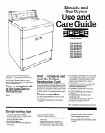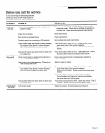
Common Laundering Problems
Problem Check if
What to do
Brown
stains
Dryer fabric softeners were used.
Wet items were stored in washer
or dryer.
Follow manufacturer’s product directions carefully.
Do Not store wet items in washer or dryer. This can cause rusting.
Color
transfer
Greasy
spots
Dryer drum is clean.
Dryer fabric softeners were used.
Undiluted washer fabric softener
was used.
Clean dryer drum thoroughly after drying tinted, dyed or non-colorfast
items. (See Page 10.)
Follow manufacturer’s product directions carefully.
Dilute fabric softener before adding to deep rinse.
Enough detergent was used.
Use enough detergent to hold soil in the wash water until it drains
away. Undrained soil can stick to outer tub of the washer and cause
greasy spots with next load.
Items were clean before they
were dried.
Soiled items can stain other items in the load. They can also leave
stains on the dryer drum that can be picked up by items in later loads.
Dryer heat may permanently set these stains.
Lint
Lint screen is clogged.
Load is properly sorted.
Static electricity is attracting lint.
Load is too big or heavy.
Paper or tissue was in pocket.
Enough detergent was used.
Pilling is being mistaken for lint.
Clean lint screen. (See Page 10.)
Sort lint-givers (bath towels, etc.) from lint-takers (synthetics, permanent
press).
Use fabric softener in the washer’s final, deep rinse. Use correct dryer
settings for fabric. Overdrying synthetics can cause lint-attracting
static electricity.
Dry smaller loads. When items can’t tumble freely, air is unable to carry
lint to lint screen.
Empty pockets carefully. A small scrap of paper can cause a lot of lint.
Use enough detergent to hold the lint in the water until it drains away.
Base detergent amount on water hardness and soil in wash load.
Pilling (surface fuzz) is caused by normal wear and laundering. Pills do
not break away easily from the fabric and can often collect lint.
Synthetic fabrics are more likely to pill than others, especially at
neckbands, elbows and knees.
Shrinking
Items are overdried.
Remove items while there is still a trace of moisture. Some items should
be removed while damp, then shaped and air-dried. Use LESS DRY
setting if your dryer has an automatic dryness control.
Fabric type and quality is suitable
for drying.
Some knits are stretched during manufacturing. Washing and drying
returns them to the original size. This is normal. Check quality of
garment before buying. Follow fabric care label directions carefully.
Page 8














